AmIInTune?
Part One
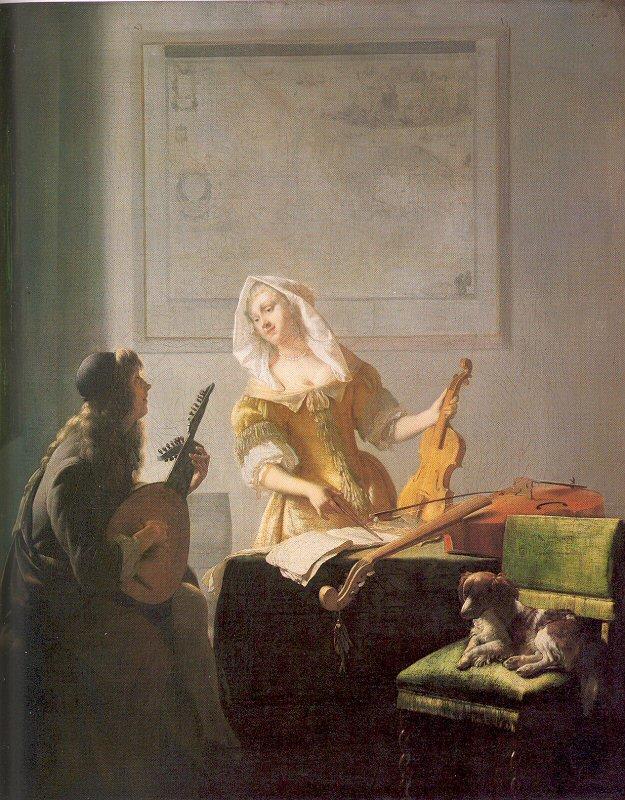
In the first two chapters we’ve discussed the general issues of music’s definition and its importance. Here we turn to a topic of more specifically musical importance and of interest to musicians themselves. It is the matter of tuning. Have you ever gone to a concert and during the intermission over-heard someone complain about the soloist, saying “Oh, she’s out of tune!” Or have you played in a band, or perhaps sat-in on a rehearsal, and heard the conductor say to someone, “You’re flat! Tune up!”? How did these people know that there was a problem? What does it mean to be “in tune”? “In tune” with what? Who decides? And how do they know?
Look at the keyboard reproduced below.[Ex.VI.2] Haven’t you wondered about that configuration? There are long and short levers, and white leavers and black levers, and the white leavers partially separated by black leavers and white leavers adjacent to other white levers. Doesn’t that look like a rather whimsical design? Is there a reason for that pattern?
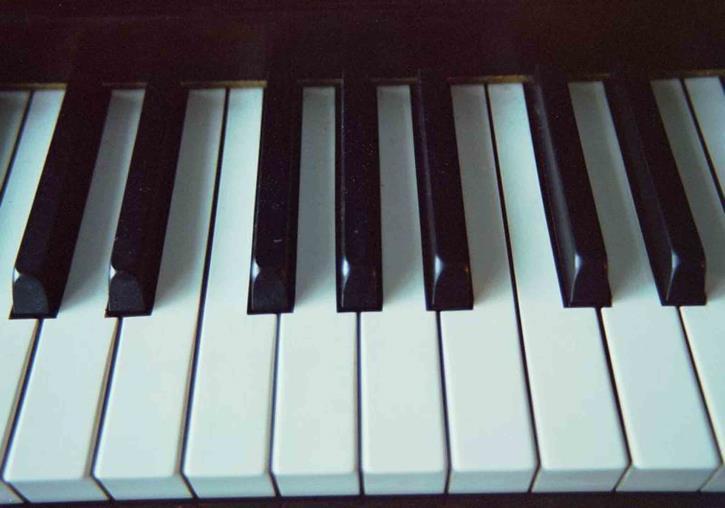
And consider the way we talk about musical pitches. We give them letter names: A, B, C, D, E, F, G (and if you’re German there’s a ‘H’ that you use for B natural; the ‘B’ in Germany is what we call a ‘B flat’). As you look at that series wouldn’t it be reasonable to think that since these are all regular letter names (meaning that there’s nothing here like a ‘B plus x’ or an ‘D minus’ or a ‘Fq2’ but instead just plain ‘B’ and ‘D’ and a plain ‘F’), that the relationship between adjacent letters would be the same? Shouldn’t the relationship between the adjacent letters of ‘D’ and ‘E’ be the same as between ‘B’ and ‘C’? But this isn’t the case at all, is it? In that series of ‘A, B, C, D, E, F, G’ adjacent pitches are divided by the distance of a whole step except in the cases of ‘B’ to ‘C’ and ‘E’ to ‘F’ in which cases the dividing distance is a half step. But isn’t this odd? Why are there different-sized spaces, some half-steps and others whole-steps? Why aren’t they all whole-steps or all half-steps? And what’s a whole-step anyway? How big it is? And who says so?
While we are thinking about the way we name pitches and that odd pattern of half and whole steps, consider this. Is there a difference between C-sharp and D-flat? If you go to the piano and play a C-sharp you depress the same lever that you’d depress to play a D-flat (it’s the short black lever that half way separates the white C and D keys). But if
both notes are produced by the same mechanical device why are there two names? Isn’t this redundant? But perhaps you play violin or cello. You know that on your instrument C-sharp is played in a different position than D-flat. But if you can play both pitches on the piano by depressing the same lever why can’t you do the same thing on the violin? Why isn’t C-sharp fingered exactly the same way as D-flat?
Try this experiment. Go to the piano and play a perfect fifth (you can play C and the G above it but any Perfect fifth will do). After you’ve played it, sing the major third above your lowest note without striking it on the keyboard (in other words, if you’ve playing that ‘C’ and ‘G’ perfect fifth try to sing the ‘E’ above the ‘C’ without first playing the ‘E’ on the piano). Then, after you’ve sung the pitch, strike the note on the keyboard. What do you hear? Does the pitch you’ve played match the pitch that you’ve just sung? If you listen very carefully it’s likely that they didn’t. The pitch you sang probably was a bit higher than the pitch the piano produced. Why? Were you ‘out of tune’? Or perhaps the piano is out of tune? How can you tell?
This returns us to our first question, the notion of being “in tune.” If there are such things as “half-steps” and “whole-steps” who says how big a “whole-step” must be? And, whatever the whole-step is, is the “half-step” then automatically exactly the size of one half of a whole-step or is it perhaps something else (yes, I know that sounds like a silly question but it’s not)? When someone says that I’m “out of tune”? Does that mean that my whole step not big enough, or too small? And what kind of comment is that? Is that a scientific remark, a fairly neutral observation concerning an acoustic measurement, similar to saying that my yardstick was a quarter inch too short? Or is that a musical remark about an aesthetic observation? Or perhaps it’s something else altogether.
Perhaps it’s really an act of aggression, an attempt to subjugate me to the constraints of a tuning system perpetuated by power structures political, sociological, sexual mindful of the necessity of maintaining their hegemony required for their survival? Is “correct tuning” and being “in tune” really simply an act of dominance? In that band when the conductor yells at me that my major second is “flat”, is she “right” and I’m “wrong” simply because she yells louder than I can (and do I “correct” my out of tune interval, and play it the way she wants it, only because if I don’t she’ll fire me?). Fundamentally, is being “in tune” just her opinion against mine? Just how big is a major second?
In 1896 Richard Strauss composed his tone poem Also Sprach Zarathustra inspired by Friedrich Nietzsche’s book of the same name (we’ve come across Strauss before: he wrote the opera aria sung by Pavarotti that we talked about in Chapter One). Strauss’ tone poem has an introduction that was popularized by Stanley Kubrick when the director decided to make it the main music in his movie 2001 (you know it: dah, dah, DAAAH!!..[drums: DUM dum DUM dum DUM dum DUM dum], repeat) This introduction ends with the full orchestra holding a C Major chord along with an organ but
Strauss has the organ hold the chord one measure longer than the orchestra; the orchestra drops out while the organ continues to play it. If you listen carefully to that final organ chord you’ll notice that it sounds a bit sour. We might say that the organ sounds “flat.” But is the organist perhaps playing the wrong notes? No, they are the right notes, the chord when played on the organ just sounds different than the chord the orchestra played before. Maybe the orchestra is “out of tune” and the organ is right? Or is it the other way around? Why is this sounding the way it does?
Here’s another example. Orchestras and bands today have instruments called “French horns.” They were called “French” beginning in the nineteenth century to distinguish them from traditional horns that didn’t have valves (if you go to page 32 in the first chapter you can see a Meissen porcelain goblet with a figure playing a traditional horn) and the new valves were largely developed in France. If you listen to a piece played on natural horns the instruments will sound beautiful together most of the time. But occasionally there are some surprisingly sour notes. Are the notes out of tune because the players are incompetent or is there something else going on making them so distasteful to our ears (and that word, “distasteful” is very important)?
Many of us enjoy working with various kinds of electronic instruments interfaced with our computers (called “MIDI” for “musical instrumental digital interface”). These MIDI stations allow us to alter pitch easily and subtly. We can “re-tune” keyboards and other electronic instruments to frequencies and even timbers different from those set by the instrument manufacturers. What guides our decisions when we do this kind of retuning? Again, do we just raise or lower a pitch capriciously or can there be a logic behind our decisions? And is there a tradition behind that logic?
What about the cultural aspect of music? We have already seen that all music is a function of the culture of which it is a part. To understand music fully we need to understand it within its cultural milieu. Does this mean that cultural notions influence what’s heard as a “correct” tuning? Is there such a thing as a South Indian “Perfect Fifth” that’s different from a Portuguese “Perfect Fifth”? And finally, what does “science” have to do with tuning? We’re probably all heard “A 440”. What does that mean? And can a “scientific” notion of what’s in tune trump a culture’s notion of what’s in tune?
These questions are not at all tangential to our lives as either performing musicians or music lovers. For those of us who are performers they bring us directly to both a central question of our art and to an issue which has commanded the attention of thinkers about music for at least two and a half millennia: this is the issue of “pitch” and how pitches relate to one another within the art of music. More simply put, it addresses the question, “Am I in tune?” And why?
IWe need to return to the story of Pythagoras that I introduced to you earlier. You will remember that charming story of the philosopher at the smithy, initially told by the first-century Neo-Pythagorean writer Nicomachus (ca 60 AD to ca 120 AD) in his Harmonium enchiridium or “Handbook on Harmony” and apparently repeated in almost every discussion of Pythagoras written since.1[Ex.VI.3] He found that the blacksmith’s twelve and six pound hammers sounded the interval of the perfect octave between them, that the blacksmith’s nine and eight pound hammers sound the interval of the major second and that the twelve and eight pound hammers sounded the interval of the perfect fifth. We know that hammers of different weight really don’t work this way (the example was probably invented for its easily manipulated numbers) but the story does describe a valid acoustic principle that actually can be demonstrated by marking off lengths of a vibrating string.
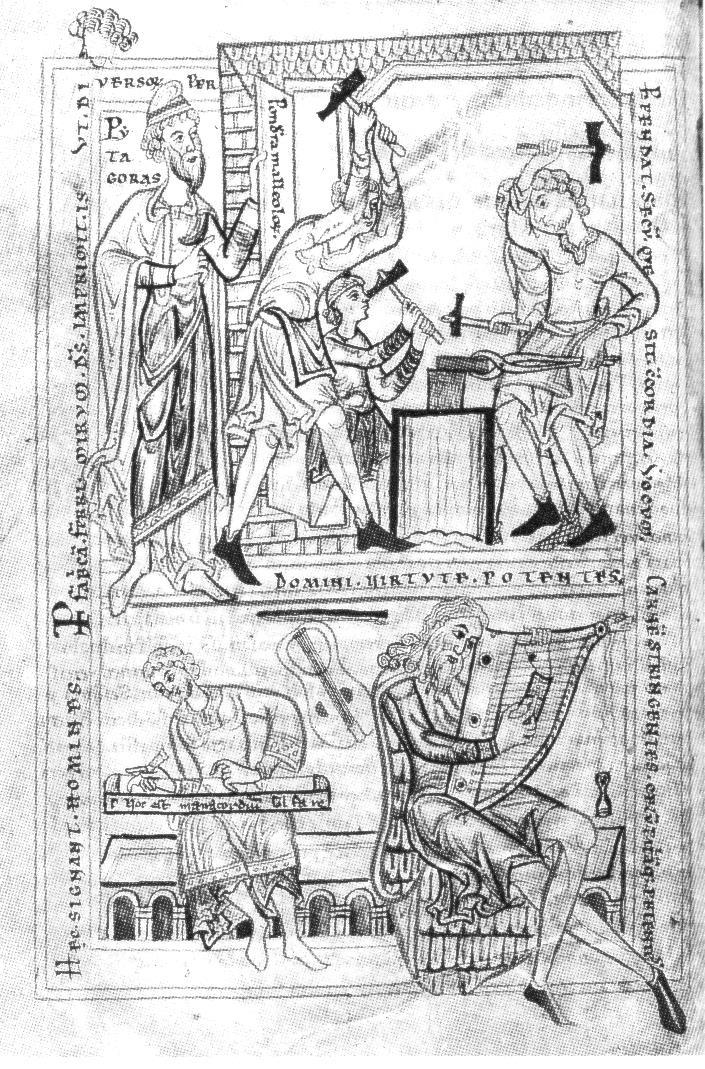
Example VI.3
The full page of the thirteenth century manuscript Bayerische Staatsbibliothek clm 259, fl 96v, showing Pythagoras at his forge, but notice the student in the lower left hand corner working with a monochord.
1 Nicomachus is best known for his “Introduction to Arithmetic.” Translated from Greek into Latin by none other than Apuleius, his “Introduction” was still used by schoolboys in the Renaissance, probably setting a record for the longevity of a textbook.
This vibrating string (which the Greeks called the kanon and the Latins the monochord) became the most important pedagogical device in the history of music. [Ex.VI.4] Consisting of a single string stretched across a sounding board, the relationships between different intervals could be demonstrated by moving the monochord’s bridge and marking the different lengths of the string. When the monochord’s string is plucked unfettered, meaning that its whole length vibrates, it produces a particular tone. It can be any tone, but for our ease we’re going to refer that tone, which we’ll call the “fundamental”, as “C”.
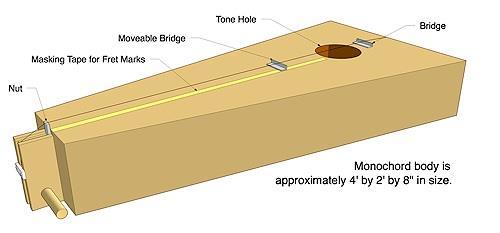
Example. VI.4 a modern plan for constructing a monochord.
If we take the string and divide it into two equal parts and then pluck the full string (which is of course both parts vibrating together), we’ll get a particular pitch. And if we then pluck just one of those two parts having dampened the string at the midpoint, we’ll get a second pitch. We can name the first pitch “two” because it’s created by two units vibrating together. And we can name the second pitch “one” because it’s created by just one of those parts vibrating by itself. The relationship between those two pitches we can precisely describe by the ratio 2:1.[Ex. VI.5]
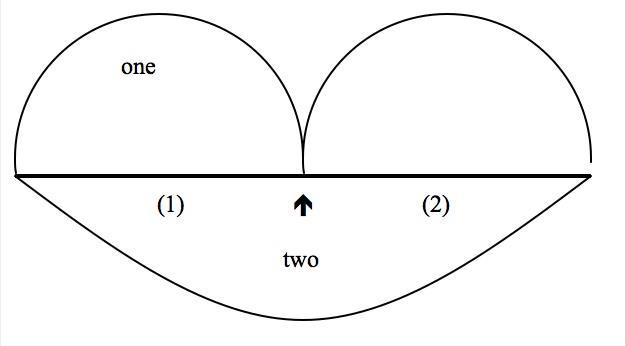
Example. VI.5
Diagram of the Pythagorean octave
< two units
< monochord string
< one unit
If, again only for convenience sake, we think of the string vibrating undamped (that is as two units together) as producing the pitch “C”, one of the divisions of the string will produce the “C” an octave above that.
But let’s divide our same string into three units. Now the “name” for our string isn’t “two” but instead “three” (and remember “three” still produces our same “C” as did “two” before). Should we now dampen our string at the end of two of our new divisions and then pluck that section which is two-thirds of the full string’s length we’ll get another pitch. This pitch is the “G” above our original “C”, or a perfect fifth higher (if you’ve forgotten whey it’s called “perfect” look back to footnote 15 in the previous chapter). The distance of the perfect fifth, or the interval (and interval is the way musicians describe distances) we can describe by the ratio 3:2, or the relationship between all of the string vibrating (which is named “three”) and just two parts of that string vibrating (which is “two”). [Ex.VI.6]
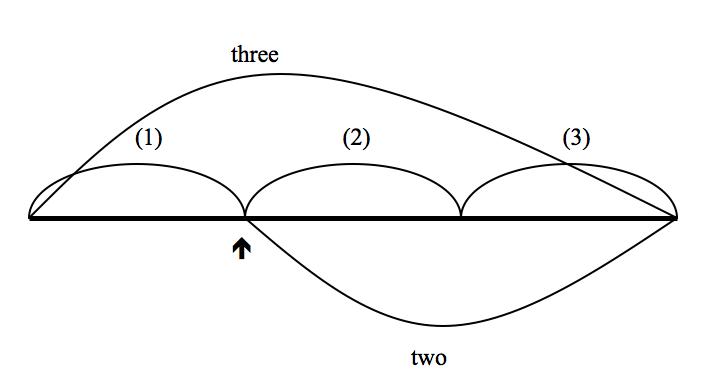
Example. VI.6
Diagram of the Pythagorean perfect fifth
< three units
< monochord string
< two units
Using this procedure of dividing our monochord we have found two intervals: the octave above our original “C” and the perfect fifth above that fundamental. And we have found that these two intervals can be defined by their relationships to the string’s total length, a relationship described by ratios. The octave is defined by the ratio 2:1 and the perfect fifth by the ratio 3:2.
But what happens when we begin manipulate these relationships? First, what happens when we take the ratio of the perfect octave and multiply by itself? We get (2:1)2. The math isn’t too hard, working out to 4:1. If we take our string and now divide it into four equally sized units and then pluck just one of those units, we’ll produce the C two octaves above our fundamental C. And should we do this again, and multiply (2:1)2 by the octave we’ll get (2:1)3 which works out to 8:1. Should we divide our monochord into eight units, pluck one of the divisions, we’ll produce the C three octaves above our fundamental pitch. If we multiply the octave by itself we produce ever higher octaves or our original pitch; one octave higher, then two, then three, then four, and so on
Second, something similar happens when we multiply the perfect fifth by itself: the process produces ever ascending perfect fifths. And we can use these ascending perfect fifths to find other intervals too. Take a perfect fifth and multiply it by a perfect fifth, or (3:2)2. This gives us the ratio of 9:4. If we divide our monochord into nine units, strike where four of these units can vibrate freely, we will produce the interval of two ascending perfect fifths or, since our fundamental is “C”, the “D” one octave and a step above that original “C”.
But if we take that (3:2)2 and then reduce it by an octave we can find the interval of the major second. It works like this: take (3:2)2 ,divide it by the ratio of the octave, which is 2:1, we get the ratio of 9:8.2 The process we just went through looks like this:
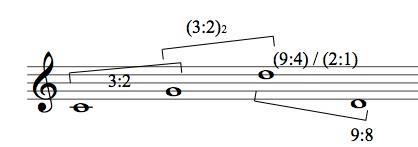
We constructed one perfect fifth (3:2), then built another one on top of that (3:2)2 , and then dropped that pitch by an octave by dividing it by 2:1.
2 (9:4)/(2:1)=(9:4)x(1:2)=9:8
And we can see this on the monochord. We take our compass and divide our string into nine equally sized units (this was basically done through trial and error because the only thing the ancients used to determine measure was the compass). The < nine
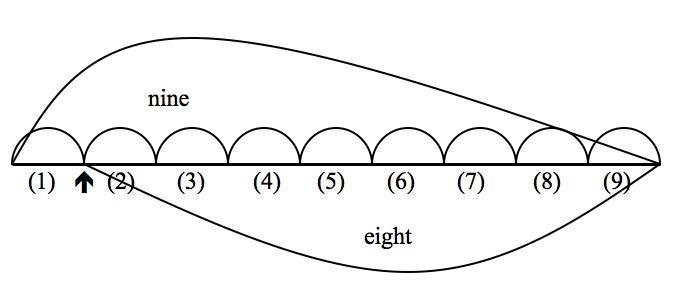
Example. VI.7
<monochord
<eight
Diagram of the Pythagorean major second “name” for the full string is now “nine.” If we count up eight of our units, dampen the string at that point, pluck the longer string, we’ll get a new pitch and the relationship between our new pitch and our original pitch can be called 9:8, the relationship between the full string and its partial. Again, if our full string vibrates at the pitch “C” the new pitch we have is “D” and the distance between the pitches is a major second.[Ex.VI.7]
Given that the fundamental pitch generated by our monochord’s string is C, here are the intervals and pitches we’ve discovered so far (again, it’s important to emphasize that what’s important here are the intervals, not the particular pitches. It’s like trying to find the definition of a “yard;” our interest is in the unit of measure not whether or not we’re measuring bolts of wool or cotton).
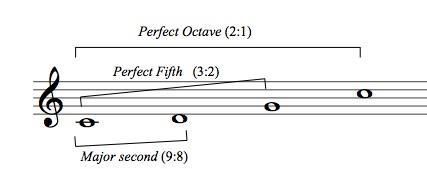
The octave can described by the ration 2:1, the perfect fifth by the ratio 3:2 and the major second by the ratio 9:8, or (3:2)2

Just as we found the perfect fifth above our first perfect fifth by squaring the ratio of 3:2, we can find the perfect fifth’s about that by the same process. (3:2)3, (3:2)4 , (3:2)5, etc. 3:2 (3:2)2 (3:2)3 (3:2)4 (3:2)5
If we reduce each of these successive fifth to pitches within our first “C” to “C” octave we find that have the diatonic scale with which we are so familiar – or almost. Here’s how it works.3
For the perfect fifth above “D”, we calculate (3:2)3, which works out to 27:8. This means that if we divide our monochord into twenty-seven equal divisions, dampen the point between the eighth section and the ninth and pluck the string we would, at least theoretically, sound the pitch “A” one octave and a major sixth above our fundamental “C.” But, since our interest is in finding the intervals within the octave we must reduce, or bring down, that “A” by one octave. This we can do by dividing the ratio 27:8 by the ratio of the octave, which you remember is 2:1. Work out the arithmetic and you get 27:16. This is the ratio of the Major Sixth.4
(3:2)4 give us the next ascending perfect fifth (in our example, from “A” up to “E”), which works out to 81:16. But to find this pitch within our original “C” to “C” octave we must reduce it. When we reduced (3:2)2 to find our major second we reduced it by one octave, or 2:1. But here we must bring down our “E” by two octaves and the ratio for two octaves is (2:1)2 or 4:1. Do the arithmetic and we get 81:64, which is the ratio of the major third.5
3 The arithmetic given here isn’t the way these matters were done in either Antiquity or the Middle Ages (for one thing these theorists didn’t have Arabic numerals). For an introduction to the way the Greeks themselves manipulated these figures see: Richard Crocker, “Pythagorean Mathematics and Music,” The Journal of Aesthetics and Art Criticism, Vol. 22 (1963), pp. 1898-198 (Part One), pp. 325-335 (Part Two).
4 27 : 2 = 27 x 1 = 27 = Pythagorean Major Sixth 8 1 8 2 16
5 (3:2)4 = 81:16 81 : 4 81 x 1 81 = Pythagorean Major Third 16 1 16 4 64
Next on our spiral of fifths (and spiral is a very important word that I’ll come back to) is (3:2)5. In our example beginning on “C” this pitch is “B.” But as before, this “B” is two octaves higher than our original octave and we must reduce it by (2:1)2 for it to serve our current purposes. Work out the arithmetic and we get 256:243. This is the ratio of the Pythagorean major seventh. If we go back to our monochord, use our compass to divide our string precisely into two hundred and fifty six equal units, count up two hundred and forty three of them, dampen the string at that point and pluck the string’s shorter section, we’ll produce the “B” a major seventh above our fundamental “C”.6
If we continue with the spiral of perfect fifths our next fifth is (3:2)6. Work-out the arithmetic and reduce by three octaves (8:1) we get the ratio for the augmented fourth, 729:512, which in our example is “F sharp.”7 That means to find this interval, we need to take our compass, find exactly seven hundred and twenty nine divisions of our string, count up five hundred and twelve of them, mark it and pluck.8
If we look over what we’ve done up to this point and refer back to our original “C” we can see that through manipulating perfect fifths and octaves we’ve come pretty close to generating the major scale that’s so familiar to Westerners (at this point it’s important to note that historically this isn’t the way the modern scale came into being but we’ll discuss that more later).

Perfect Octave: 2:1 (C to C)
Major Second: 9:8 (C to D)
Major Third: 81:64 (C to E)
Perfect Fifth 3:2 (C to G)
Major Sixth: 27:16 (C to A)
Major Seventh: 243:128 (C to B)
6 (3:2)5 = 243:32 243 : 4 = 243 x 1 = 243 = Pythagorean Major Seventh 32 1 32 4 128
7 (3:2)6 = 729 : 8 = 729 x 1 = 729 = Pythagorean augmented fourth 64 1 64 8 512
8 There is a lot of confusion about this interval, the “tritone,” some recent writers even claiming that the interval was forbidden by the medieval church. It wasn’t. It’s nickname as the diabolus in musica was an invention of Andreas Werckmeister (1645-1707), an important musician of the German Enlightenment. For a particularly confused account of the interval see: Daniel Levitin: This Is Your Brain on Music: The Science of a Human Obsession, New York: Plume/Penguin, 2006, p. i
But you’re probably already noticed that there’s something important missing here. We don’t have a perfect fourth; there’s no “F” and you would expect there to be one (and I’ll come back to that “expect” also). If we continue the ascending progression of perfect fifth’s we’ll never reach an “F” because that progression is a spiral, it continues without ever returning to its origin. Our progression moves from “F sharp” to “C sharp”, to “G sharp”, to “D sharp”, to “A sharp” and then to “E sharp” (and then “B sharp”, “F double sharp”, etc.). But this “E sharp” is not the same pitch as “F”. The “E sharp” is (3:2)11 which works out to 177,147: 2,048. Reduce this by (2:1)6 and we get 177,147:131,072. This in turn can be reduced to 4.43:3.28 which is the ratio of the augmented third.
To find the interval of the perfect fourth we must abandon our spiral of perfect fifths and instead find the difference between the perfect fifth and the octave; that difference is the perfect fourth, 4:3 (and I’m going to come back to the difference between the augmented third and the perfect fourth a bit later).9
Now, with the addition of our perfect fourth of 4:3 we have all the intervals of what we call today a major scale and we can answer at least one of the questions with which be began this chapter: why do we have this odd configuration of half and whole steps between adjacent letters? The development of our system scales and the naming of notes is rich and very complex and while this is a great simplification it’s largely true: that pattern grows out of a tradition of creating “right” intervals through Pythagorean principles.
You will remember from the previous chapter our introduction to Pythagoras and our addition to that theorem we all learned: in the matter of a right triangle A2 + B2 = C2 always. It’s that always that’s so important and testified to the Greeks of the changeless, and therefore divine, character of numbers.
I’ll expand on this in a bit later, but for now it’s important to note that we known when a major second is in tune when the interval is defined by the ratio 9:8. We know when a perfect fifth is in tune when the interval is defined by the ratio 3:2. It’s when the numbers are right that we know the interval is “right” because, by their very nature, the numbers are changeless and hence, again in this Pythagorean tradition, divine. And these numbers do seem to be remarkably consistent. We’ve already seen that we can construct a major third by reducing (3:2)4 by two octaves, giving us the ratio of 81:64. But if we stack one major second on top of another major second, that also should make a major third, and it does: 9:8 multiplied by 9:8 equals 81:64. Similarly, should we stack a major third on top of a perfect fifth we should be able to create a major sixth. And it
9 (2:1) : (3:2) = 2 x 2 = 4 = Pythagorean Perfect Fourth 1 3 3
does: 3:2 multiplied by 9:8 equals 27:16. What is the difference between a perfect fifth and a perfect fourth? A major second. Do the arithmetic as we get 9:8, just as we should. And should we stack perfect fifth on top of a perfect fourth we create an octave. Do the ratios work? Yes they do, 4:3 x 3:2 reducing to 2:1.
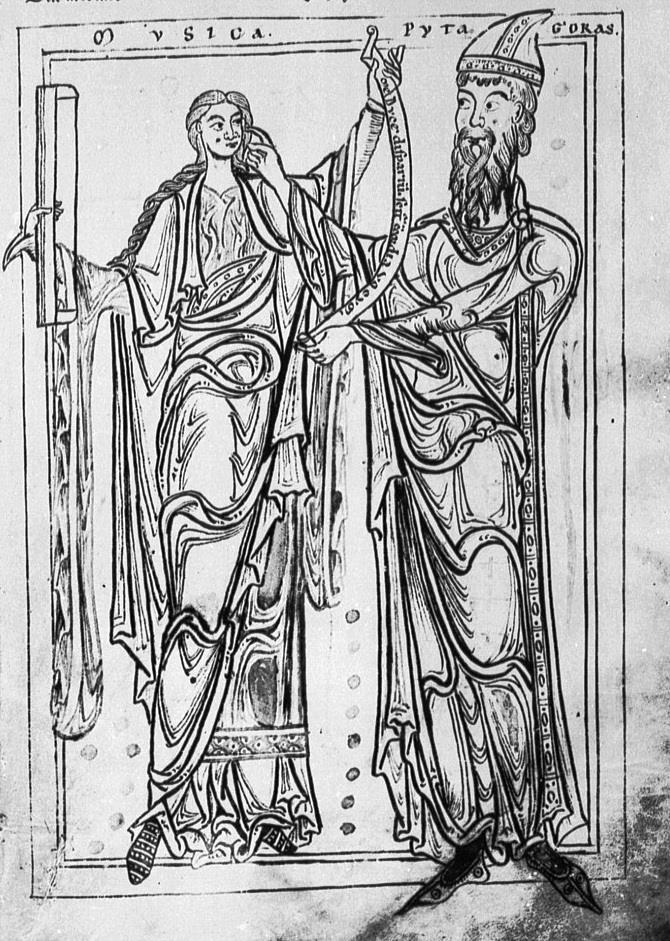

Library
We can figure the minor second by finding the difference between the perfect octave and the major seventh. When we do the arithmetic we get the ratio of 256:243.10 But there is also the interval of a minor second between a major third and a perfect fourth. Is the difference between these intervals the same ratio as between the perfect octave and the major seventh (as it should be)? Do the arithmetic and yes, it is: 256:243.11 We can also find this minor second by creating a major third by stacking two major seconds and then subtracting that interval from the perfect fourth.12
The Greek work Euclid uses for “ratio” is “logos” (λόγος) a word with a rich, and deeply complex, tradition in western philosophy. The Stoics used it to mean the reason uniting the universe, a notion we see reflected by the writer of the Gospel of John were he began his account with the line, “In the beginning was the logos and the logos was with God and the logos was God.” Logos here isn’t just a fundamental principle, it is the personality of God incarnated in Jesus of Nazareth (in most English Bibles “logos” is translated as “word” following Martin Luther’s lead when he translated the text into German). The consistency of the Pythagorean ratios testifies to the existence fundamental principles that unite all existence and harmonizes of the cosmos into a rational whole.
Well,almostbutnotquite. Ifyoudivideanorangeinhalf,whatdoyouget? Twohalvesofanorange.Ifyoutaketheorangeyou’vedividedandendupwithone partthreequartersthesizeofyouroriginalorangeandasecondpartonequarter thesize,you’vemadeamistake. You’vesplityourorangebutyouhaven’tdividedin half. Andifyou’rehawkingbothpartsashalfanorangeandsellingthemforthe samepricesomebodyisgoingtobecheated.
LetstobacktothePythagoreanhalf-stepwecreatedbytakingthemajor seventhawayfromtheoctave. Thatprocessgaveustheratio256:243. Andwe alreadyknowthatourwholestepis9:8. Now,quickly,whatratioshouldwegetif wetakeahalfstepawayfromawholestep? No,don’tdoanyarithmetic. Justthink Shouldn’thalfofawholestepbeahalfstep? Shouldn’ttheratiobe256:243? Right? Ofcourse. Butitisn’t.Thedifferencebetween9:8and256:243is2187:2048.
10 (2:1) : (243:128) = 2 : 243 2 x 128 = 256 = Pythagorean minor second (diesis or limma) 1 128 1 243 243
11 (4:3) : (81:64) = 4 : 81 = 4 x 64 = 256 = Pythagorean minor second (diesis or limma) 3 64 3 81 243
12 (4:3):(9:8)2 =254:243=Pythagoreanminorsecond (diesis or limma)
Bluntly,thisratioshouldn’texist,butitdoesandthishasbeenoneofthe mostcontroversialandproblematicmattersinthehistoryofmusic. InPythagorean tuningwefindourselvesconfrontedbytwodifferenthalfsteps. Thehalfstepwe calculatedbyfindingthedifferencebetweentheperfectoctaveandthemajor seventh(andthedifferencebetweentheperfectfourthandthemajorthird),is calledthe“diatonic”minorsecondorthe“Pythagoreandiesis”(whichmeans “difference”)orthe“limma”(whichmeans“remnant”). It’stheratio256:243. “Cent”isamodernunitofacousticmeasurement. One“cent”isone-onehundredth ofanequallytemperedhalf-step(Iknowthatwehaven’tdiscussedequal temperamentyetbutwewill;fornowjustthinkofa“cent”aslikeamillimeter,a simpleunitofmeasure).13 Oneequallytemperedhalfstepis100cents. Thediesis minorsecondis90.22cents,meaningthatit’sslightlylessthentenpercentsmaller thanthehalfstepwe’reaccustomedtohearingonthepiano. Theotherhalfstep,the onewiththeratio2187:2048iscalledthe“apotome”. Itisdifferencebetweenthe majorsecondandthediesisandis114cents,makingitsignificantlylargerthanthe equallytemperedhalfstepof100cents. Thedifferencebywhichthelarger apotomeexceedsthesmallerdiesisiscalledthe“Pythagoreancomma”andis 531,441:524,288whichis23.5.
Twentythreeandahalfcentsisasignificantsizeandcanbeeasilyheardand willbeasignificantissueforus. Butwehavetorememberthatforthe PythagoreansofAntiquity(andsometheirdisciplesevenintotheRenaissance) “music”wasnotsomuchaboutsoundthatstrikestheearbutinsteadacalculation thatstrikesthemind. Themusicofmusicians,withsomeimportantexceptions (suchasthestoryaboutAlexandertheGreatwereadearlier),playsgenerallya smallroleinPythagoreanthought. Hellenisticculturehadarichandvibrant musicaltraditionandyoucan’thelpbutbestruckbythefactthattheintonationof suchimportancetothePythagoreansandclassicalNeo-Platonistshadverylittleto dowiththescalesmusicianswereusingtomake theirmusic.14
Butthisissuewasn’tmissedbytheancientmusiciansthemselves. Aristoxenus(c.375–360B.C.),apupilofAristotle’sinAthensandthegreatest
13 The “cent” was developed by the English polymath Alexander Ellis (1814-1890) who not only wrote on comparative musicology but also mathematics and philology and was George Bernard Shaw’s model for Professor Henry Higgins in his1912 play Pygmalion (which served as the basis for the music My Fair Lady).
14 Greek scales could take on at least three forms: a diatonic, a chromatic, or an enharmonic. The difference between these three can be demonstrated in the varying construction of their initial tetrachords. The intervals of the diatonic tetrachord descended in the order: tone, tone, semi-tone. The descending order of the chromatic: three semi-tines, semi-tone, semi-tone. And the enharmonic, again descending: two whole tones, quarter-tone, quarter-tone. These three genera could be further altered through forms called “soft,” “hemiolic,” “tonal,” or “tense,” But Pythagorean calculations only produce the diatonic scale, ignoring all other forms. See: R. P. Winnington-Ingram, “Greece, I” The New Grove (1980).
theoristofantiquity,arguedagainstthePythagoreansbyinsistingthatthetrained ear,andnotthecompassandmonochord,wasthefinalauthorityinallargumentsof intonation. Heinsistedthatallmusicalintervalsshouldbemeasurednotbyratios butinsteadbynumbersoftonesandfractionsofatone. Theperfectfourthshould bedefinedbythesumoftwoandahalfwholetonesandthemusician--notthe philosopher--wastheonewhodecidedwhatsizethesemi-tonewas.15 Aristoxenus wasnotaloneinchampioningthetrainedear. Apparentlytherewasawholeschool ofphilosophersholdingthatposition,aschoolofthoughtthatlastedwellintothe Romanperiod. Theophrastus(c.371–c286BC),Aristotle’ssuccessorinAthens, calledsuchthinkers harmonikoi,or“thosewhojudgebysenseperception”as opposedtothosewhogiveamathematicalaccountofintervals.16 Therewereeven attemptsatreconcilingthetwopositions,asevidencedbythefragmentary Pythagorean Elements of Music bytheladyphilosopherPtolemaisofCyreneand On the Difference between the Aristoxenians and the Pythagoreans byDidymus,a theoristwritingduringthereignoftheRomanemperorNero. 17
15 M.L.West, Ancient Greek Music,pp.167,233
16 Ibid.,p.281(note1)
17 Ibid.,p.239
II
We will return to the business of these numbers in a moment but before we do I’d like to take some time and look at the influence those numbers have had on Western Civilization. We touched on this in our previous chapter but now, after having looked at the ratios we’re equipped to look at the mater a little more closely.
We often forget by how slender a thread ancient literature was preserved into the Middle Ages. The poem of Catullus (c. 84 – 54 BC), who was the greatest lyric poet of Rome, escaped destruction in only one manuscript. Once held in the Italian city of Verona, that manuscript was itself lost in the twelfth century but not until after two copies had been made that now serve as our only sources for this great poetry. And while the case of Catullus may be extreme it serves as a reminder that every civilization is only one generation old. The accomplishments and monuments of thousands of years can be completely annihilated should only one generation choose not to preserve them. And once gone they can be recovered only by the greatest toil, it at all. Look at the Mayans.
Anicius Manlius Severinus Boethius (c. 480 – c 524 AD) was acutely aware of this responsibility.18 Living in an age where fewer and fewer of his fellow Romans knew Greek and when his German conquerors were beginning to transform his native Latin into what would become Italian, Boethius resolved to translate into Latin some of the great intellectual accomplishments of the Greeks and thereby preserve them. Since adequate Latin translations and commentaries already existed for the disciplines of grammar, rhetoric, and dialectic, (called the Trivium), Boethius chose to focus upon what were thought of as the “mathematical disciplines:” arithmetic, music, geometry, and astronomy, a quartet of subjects Boethius called the Quadrivium 19
Boethius’ books on geometry and astronomy were lost apparently fairly soon after they were written. And even though his work on music was only partially preserved into the Carolingian period (the extant text breaks off in midsentence near the beginning of book five), De institutione musica (“The Principles of Music) became the most important text on music throughout the Middle Ages and Renaissance. At Oxford, it was still used as a text at the end of the eighteenth century. If we remember his “Consolations of Philosophy,” which were also a core of traditional instruction, it could be argued that
18 ForanintroductiontoBoethius’lifeandworksee: HenryChadwick: Boethius, The Consolations of Music, Logic, Theology, and Philosophy (Oxford: ClarendonPress,1981).
19 BoethiusapparentlyborrowedthisdivisionoflearningfromMartinusMinneusFelixCapella’s The Marriage of Mercury and Philosophy,aworkusuallydatedbetween460and470. Martianushad takenthedivisionfromthesecondcenturyBC Disciplinarum libri IX ofVarro,althoughthatearlier workhadalsoincludedthe“utilitarianarts”ofmedicineandarchitecture. SeeHenryChadwick, op cit,p.21
Boetheus was the most influential non-theological writer in the West until the 19th century.[Ex.VI.8]

ExampleVI.8 from On the Consolation of Philosophy by Boethius, Italian MS ca. 1385 Boethius teaching (above) and imprisoned awaiting execution (below) the Glasgow University Library MS Hunter 374 (V.1.11), 4r
In De institutione musica Boethius draws heavily on Ptolemy’s (ca 90 – ca 168 AD) Harmonica and Nicomachus’ (c. 60 – c. 120 AD) Handbook on Harmonics. He references both Plato’s Timaeus and Republic in his discussion of the affect that music has upon morals and character. He divides music into three kinds: cosmic (musica mundana), human (musica humana), and instrumental (musica instrumentalis). Instrumental music, by which Boethius means singing and performing music on instruments, is the most base type. “Cosmic” music is the “music of the spheres,” or the relationship between the elements of the cosmos expressible in harmonies and intervallic ratios. “Human music” is the joining together of the disparate elements which constitute the “single consonance’ of the human being. Boethius repeats the tale of Pythagoras at the smithy, presents the calculations of Pythagorean ratios (and includes discussions of the Pythagorean comma and dieses) and, while acknowledging the existence of the chromatic and enharmonic forms of the scale, opines that the Pythagorean diatonic scale is superior to them on the authority of Timaeus. Boethius thus bequeaths to modern Europe a highly Pythagorean and Neo-Platonic musicology, a bequest that profoundly affected our music in at least four ways.
First, and probably of the greatest importance for us as musicians, is the standardization of Pythagorean intonation throughout Western Europe where it remained largely unchallenged for almost 1,000 years. This was not accomplished for aesthetic reasons but rather rested upon the enormous prestige which Pythagoras, Plato, Ptolemy and Boethius commanded with intellectuals in Western Christendom. Generally, medieval authors had a profound respect for the culture of Classical Antiquity and a great love (I really don’t think that any other term will do) for the writing of ancient authors. They loved books, treasured them (literally, they were regarded as treasure), believed almost anything in them, and did almost anything they could to preserve them, copying and re-copying ancient texts at a cost of great toil and expense.20 Taking their cue from “the master” Boethius, writer after writer begins their treatises on music with discussions of the divisions of the monochord. This dialogue, attributed to Odo of Cluny and preserved in the tenth-century Enchiridion musices (“Handbook on Music”) is typical of many.
Disciple: What is the monochord?
Master: It is a long rectangular wooden chest, hollow within like a kithara; upon it is mounted a string, by the sounding of which you easily understand the varieties of sounds. . .
Disciple: How does the string produce many different sounds?
Master: The letters, or notes, used my musicians are placed in order on the line beneath the string, and when the bridge is moved between the line and the string, shortening or lengthening it, the string
20 For more on the respect Medieval writer had for Greco-Roman authors see: C.S. Lewis, The Discarded Image: An Introduction to Medieval and Renaissance Literature (Cambridge: 1967), Chpt. 1.

ExampleVI.9 from a twelfth-century copy of Boethius’s De Musica, showing the philosopher seated with a monochord in the upper left-hand corner with other figures representing Pythagorean intervals (with hammers and bells) and musica mundana (seated on a celestial orb) and musica instrumentalis below.
Cambridge University Library, MS Ii.3.12, ff 73v-74
marvelously reproduces each melody by means of these letters. When any antiphon is marked with the same letters, the boys learn it better and more easily from the string than if they heard someone sing it, and after a few months’ training, they are able to discard the string and sing by sight alone, without hesitation, music that they have never heard.
Disciple: What you say is very marvelous. Our singers, indeed, have never aspired to such perfection.
Master: Instead, brother, they missed the right path, and failing to ask the say, they labored all their life in vain.
Disciple: How can it be true that a string teaches more than a man?
Master: A man sings as he will or can, but the string is divided with such art by very learned men, using the aforesaid letters, that if it is diligently observed or considered, it cannot mislead.
Disciple: What is this art, I inquire.
Master: The measurement of the monochord, for if it is well measured, it never deceives.
Disciple: Can I perchance learn the exact measurements, simply and in a few words?
Master: Today, with God’s help, only listen diligently.
(here follows a demonstration of the monochord)21
Odo is absolutely clear. Correct intonation is shown by the monochord, not by singers who have “labored all their life in vain.” The monochord “cannot mislead” with the clear implication that instruction lacking it will. Writing about two hundred years later, John (we know little about him apart from his name) concludes his own discussion of the monochord with the line, “As we said, the monochord serves to silence their wrong-headedness, so that those who still not trust the words of a musician are refuted by the testimony of the sound itself.”22 Here again, intonation is “proven” by the monochord. In both cases, it is not the ear that establishes intonation but rather calculation, arithmetic, and the prestige of Boethius’s model. The Medieval view, taken from Boethius, is a rigidly Pythagorean method if tuning; Aristoxenus’ view that the ear alone is the only valid judge is forgotten, or ignored.
But not only Pythagorean intonation became the standard tuning in the Middle Ages but also what we may call “Pythagorean/Ptolemaic cosmology” became a fundamental component of the Medieval world view. This is the second part of
21 Enchiridion musices, attributed to Odo of Cluny, edited and translated by Oliver Strunk, Source Readings in Music History (New York: W. W. Norton & Company, 1950), p. 105. 22 The “they” to whom John refers are bad students (he actually calls them “devil possessed,” energumenos) who, when corrected when they misperform a chant, “get angry and make a shameless uproar and are unwilling to admit the truth but defend their error with the greatest effort.” John, De Musica, translated by Warren Babb, Huchbald, Guido, and John on Music, Three Medieval Treatises (New Haven: Yale University Press, 1978), p. 110.
Boethius’ legacy. We already know the basic outlines of this cosmology from classical Pythagoreanism. In the late Classical period aspects of Plato and Ptolemy are added to it creating the idea that music is a fundamental aspect of the physical universe. But writers in the Middle Ages and the Renaissance took the mythology to new lengths. They believed that the orbits of the planets around the earth could be described by ratios. Those rations also described musical intervals and even pitches. These pitches, in turn, could be organized into modes. Thus the cosmos could be described, literally, as music, with specific pitches assigned to the heavenly bodies and the relationships between them described by modes. In 1496, Franchinus Gafurious (1451-1522) included a woodcut of this musical cosmos as the front piece of his great treatise, Practica musicae. At the bottom of the page is the earth (Terra). Above the earth we see the orbiting planets, each with its own muse, pitch, and mode. Clio, muse of the moon, “sings” an “A.” Calliope,
“By virtue of his intellect has Apollo set [the cosmos] moving.”
Apollo
The Three Graces enthroned
(Muse) (Planet) (Pitch) (Mode)
Stellatum Urania A Hypermixolydian (tone)
Polihymnia Saturn G Mixolydian (tone)
Euterpe Jupiter F Lydian (semitone)
Eratho Mars E Phrygian (tone)
Melpomene, Sun D Dorian (tone)
Terpsicore Venus C Hypolydian (semitone)
Calliope Mercury B Hypophrygian (tone)
Clio the Moon A Hypodorian
Thalia Terra (earth)
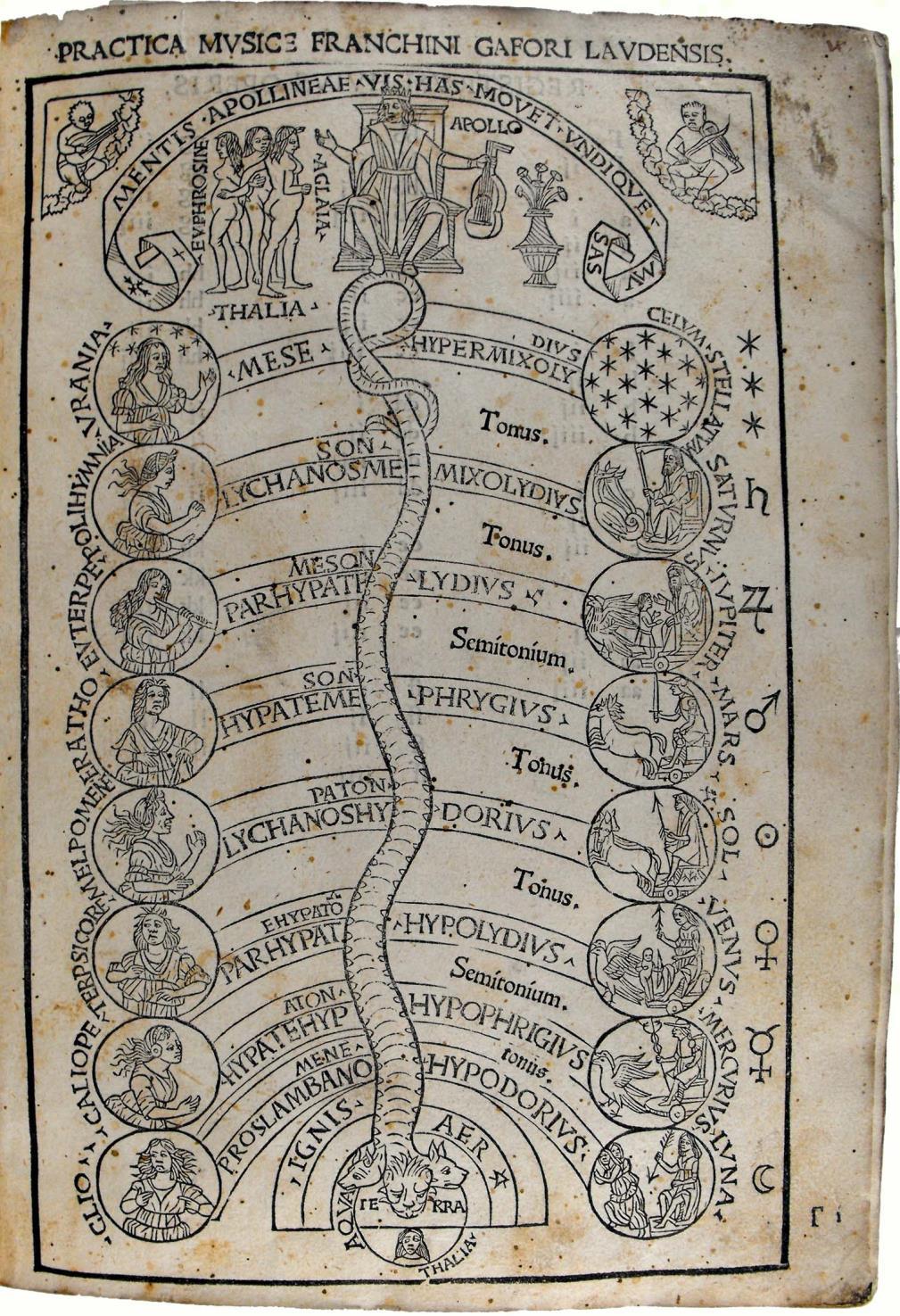
for Mercury, sings a “B”. Terpsicore, for Venus, sings a “C”. Melpomene, on the Sun, sings a “D.” Eratho, on Mars, sings an “E.” Euterpe, on Jupiter, sings a “F” and Polihymnia, on Saturn, sings a “G.” In the sphere of the stellatum, Urania completes the octave and sings an “A.” Above the stellatum, in the caelum ipsum, sits Apollo, enthroned, surmounted by the motto: “By virtue of his intellect has Apollo set [the cosmos] moving.” The life-blood of the cosmos which animates it with movement, is music.23
Even after the Ptolemaic model had been abandoned in favor of Copernicus’ (1473-1543) heliocentric universe (where the earth and the other planets revolve around the sun), the old cosmology still exercised a powerful pull on thinkers’ imaginations. We’ve already come across Shakespeare’s speech in the fifth act of The Merchant of Venice where Lorenzo echoes Plato and Cicero’s reasons for our inability to hear the music of the spheres.
Howsweetthemoonlightsleepsuponthisbank! Herewillwesitandletthesoundsofmusic Creepinourears:softstillnessandthenight Becomethetouchesofsweetharmony. Sit,Jessica.Lookhowthefloorofheaven Isthickinlaidwithpatinesofbrightgold: There'snotthesmallestorbwhichthoubehold'st Butinhismotionlikeanangelsings, Stillquiringtotheyoung-eyedcherubins; Suchharmonyisinimmortalsouls; Butwhilstthismuddyvestureofdecay Dothgrosslycloseitin,wecannothearit.24
Johannes Kepler (1571–1630), whose three laws of planetary motion validated Copernicus’ cosmology, spent much of his life trying to reconcile the heliocentric universe with the old Neo-Platonic/Pythagorean mythology. In his De Harmonice Mundi, published in Augsburg in 1619, he argued that the pitches of the planets depended upon their relative velocities (which change as each planet progresses through its elliptical orbit), pitches which are heard only by the “soul” that animates the sun. John
23 Gafurius’ woodcut is a Renaissance attempt at re-paganizing a pagan antique cosmology that had been substantially Christianized in the Middle Ages. In Medieval iconography, God the Father sits enthroned in the caelum ipsum, surrounded by His angels and saints. By the power of His love, God sets the primum mobile into motion, i. e. , he gives life to the universe. Apparently trying to present a model of Plato’s cosmos form the Timaeus in other words a Pythagorean/Neo-Platonic pre-Christian cosmos Gafurius’ artist takes that Christianized model, puts Apollo on the heavenly throne, substitutes the three graces for the cherubim, and replaces God’s love as the primum mobile by Apollo’s intellect. But in the Timaeus, Plato stubbornly refuses to identify God, calling him only “the god who is forever”, and while the direction of the primum mobile’s movement is clear, its cause isn’t.
24 Shakespeare, The Merchant of Venice, Act V, scene i.
Milton (1608-1674), writing a generation later, has Adam hail the first day of creation in his 1667 Paradise Lost as that “mystic dance, not without song.”
These are thy glorious works, Parent of good, Almightie, thine this universal Frame, Thus wondrous fair; thy self how wondrous then! Unspeakable, who sitst above these Heavens To us invisible or dimly seen In these thy lowest works, yet these declare Thy goodness beyond thought, and Power Divine: Speak yee who best can tell, ye Sons of Light, Angels, for yee behold him, and with songs And choral symphonies, Day without Night, Circle his Throne rejoycing, yee in Heav'n, On Earth joyn all ye Creatures to extoll Him first, him last, him midst, and without end. Fairest of Starrs, last in the train of Night, If better thou belong not to the dawn, Sure pledge of day, that crownst the smiling Morn With thy bright Circlet, praise him in thy Spheare While day arises, that sweet hour of Prime. Thou Sun, of this great World both Eye and Soule, Acknowledge him thy Greater, sound his praise In thy eternal course, both when thou climb'st, And when high Noon hast gaind, and when thou fallst. Moon, that now meetst the orient Sun, now fli'st With the fixt Starrs, fixt in thir Orb that flies, And yee five other wandring Fires that move In mystic Dance not without Song, resound His praise, who out of Darkness call'd up Light. 25
The “harmony” of the heavens (which is the balance between extremes, not the concord between different music pitches with which we associate the term today) was another aspect of Boethius’ musica mundana. As well as describing the delicate balance between elements observed in the heavens it was also was reflected in the harmony of the human being, or the musica humanis, something we discussed in the previous chapter.
Music can restore health, or harmonia, because music and the harmonies of the cosmos are one in the same: they are number. And number is an object of thought and contemplation, not something experienced through the senses. This is our third legacy from Boethius: the division of those who “think” about music from those who “merely” perform it and write it, or what was known in the Middle Ages as the division between musici and cantors, “musicians” and “singers.” Guido d’Arezzo (991? – 1050) is
25 John Milton, Paradise Lost, Book V, lines 153-179
unusually blunt with he begins his Prologus antiphonariis sui with “In our times, of all men, singers are the most foolish,”26 but his comment testifies to the sharp division drawn between the superior contemplator of music and the lowly performer of musical pieces. Singers (canti) and not musicians (musici). We have already seen where the origins of this notion lie in Antiquity. Those precedents are taken-up by Augustine when he writes that the proper object of thought is not “the art but the science of music.”27
Boethius classifies three types of “musicians.”
He however is a musician who on reflection has taken to himself the science of singing, not by the servitude of work but by the rule of contemplation – a thing that we see in the work of buildings and wars, namely in the opposite conferring of the name. For the buildings are inscribed and the triumphs held in the names of those by whose rule and reason they were begun, not of those by whose labor and servitude they were completed.
Thus there are three classes concerned with the musical art. One class has to do with instruments, another invents songs, a third judges the work of instruments and the song. But that class which is dedicated to instruments and there consumes its entire efforts (as for example the players of the kithara and those who show their skill on the organ and other musical instruments) are separated from the intellect of musical science, since they are servants, as has been said, nor do they bear anything of reason, being wholly destitute of speculation. The second class having to do with music is that of the poets, which is born to song not so much by speculation and reason as by a certain natural instinct. Thus the class also is to be separated from music. The third is that which assumes the skill of judging, so that it weights rhythms and melodies and the whole of song. And seeing that the whole is founded in reason and speculation, this class is rightly reckoned as musical, and that man as a musician who possesses the faculty of judging, according to speculation or reason, appropriate and suitable to music, of modes and rhythms and of the classes of melodies and their mixtures and of all those things about which there is to be discussion later and of the songs of the poets.28
Performers on instruments cannot understand the “reason” of music and are therefore “destitute of speculation” which, I think, means that they aren’t able to juggle the math of the ratios. Without understanding they are but servants. They have a “certain natural instinct” for invention but little else, which means that they’re a bit like animals. A twelfth-century writer compares a singer with a drunk, “who does indeed get home but does not in the least know by what path he returns.” Such a singer only holds the road by
26 Guido of Arezzo, Prologus antiphonarii sui, in Source Reading in Music History, p. 117. But to be fair to Guido (as well as to other medieval writers), I should point out that his purpose in writing is not to ridicule the singers but rather to make them into musicians, not always an easy task.
27 Quoted by Henry Chadwick, Boethius, p. 87.
28 Boethius, De institutione musica, Source Readinsg in Music History, p. 86.
habit, whereas “the musician always proceeds correctly and by calculation. . .”29 Musicians are those who can think about the music, who know it by calculation. And it’s through calculation that they can grasp the “whole” of music.
Of course there is a good deal of simple social snobbery here, as there was in Classical Antiquity too. For the most part performing musicians came from the lower classes, philosophers from the upper (Boethius counted two Roman emperors among his ancestors). But there is more at work here besides aristocratic disdain. It isn’t only that the lower orders play music and the upper ponder it but rather the kind of thing the philosophers tended to think about and call “music” was really a very different sort of thing than what the lower orders composed, sang, and danced to. For Boethius and his intellectual descendants as it was for the earlier Pythagoreans and Neo-Platonists music is something which elevates the soul to divine realms, an ascent possible because music and the heavens share a common language: number. The pure contemplation of music is the contemplation of the divine in the form of numerical relationships: 3:2, 4:3, 81:64, etc.
When we read medieval authors writing about the importance of music we must be careful not to misunderstand them. Sometimes, as when they are writing handbooks for training boys to sing (as in the case of Guido d’Arezzo), they are indeed talking about what we today would recognize as “music.” But frequently what they are referring to as “music” we would either call “geometry” or even perhaps “number games.” Today, when we talk to someone and hear him say that he found a particular musical performance “heavenly” or that he was in some way “moved” by a particular piece we understand him to mean that the piece of music or the particular performance had a powerful emotional impart upon him. He was moved emotionally, and this is what we talked about at some length in the previous chapter. But apparently for most Medieval writers it was the abstract importance of the numbers that interested them and that interest was intellectual, not emotional.
But there is at least one very important exception to this rule: the case of St. Augustine (354-430). Augustine was the bishop of the North African city of Hippo and his extensive writings had an enormous influence in the development of Western Europe. Although elsewhere he attested to the intellectual importance of music in a typically Pythagorean fashion, in his Confessions (which is his autobiography) he wrote of music’s powerful emotional impact upon him, apparently driving him near to what he feared was idolatry.
How much I wept at your hymns and canticles, deeply moved by the voices of your sweetly singing Church. . . But when I recall the tears which I shed at the song of the Church in the first days of my recovered faith, and even now as I am moved not by
29 John, On Music (trans. by Warren Babb), p 105
the song but by the things which are sung, when sung with fluent voice and music that is most appropriate, I acknowledge again the great benefit of this practice . . . Yet when it happens to me that the song moves me more than the thing which is sung, I confess that I have sinned shamefully and then prefer not to hear the singer. Look at my condition! Weep with me and weep for me, you who so control your inner feelings that only good comes forth. And you who do not behave thus, these things more you not. You however, O Lord my God, give ear, look and see, have pity and heal me, in whose sight I have become an enigma unto my self; and this itself is my weakness.30
This passage is remarkable on so many levels that it probably deserves its own book (and so much has been written on Augustine that it probably has had one) but for our purposes here it’s enough to note that despite the silence of so many early writers on the matter, the strongly emotional nature of music which allows us to order our emotional lives – which you will remember I thought was music’s fundamental character at the end of the last chapter – was not unknown in late Antiquity; it was at least known to Augustine and he wrote about it thinking that his readers would understand too.
The fourth part of Boethius’ legacy is institutional: because of him music is part of the Liberal Art’s Quadrivium. Because of the ratios of its intervals, Boethius included it with the three other mathematical arts: arithmetic, geometry, and astronomy. And it’s through its inclusion in the Quadrivium that music becomes a founding part of the universities that grew up in Europe beginning in the twelfth-century. It is also because of its inclusion in the Quadrivium that medieval thinkers came to understand music as one of the primary components of civilization. The designers of Chartres Cathedral chose to give this last notion a particularly dynamic expression when, in the voussiors of south portal on the cathedral’s great western façade, they surround the infant Christ, enthroned on the Virgin Mary, with personifications of the liberal arts. There, along with the other members of the Quadrivium and Trivium (grammar, rhetoric, and dialectic) we see the muse of Music, with a psaltery on her lap and a viol hanging behind her, striking three bells (perhaps for the perfect consonances of the fifth, fourth, and octave), with Pythagoras, working at a lap desk, beneath her.
30 Augustine, Confessions, IX, 14; X, xxxiii, 50.



Previous page: Chartres Cathedral, west façade, largely constructed between 1193 and 1250. This page: left: tympanum above the south door (far right in the picture of the façade) showing the infant Jesus on the lap of Mary with scenes of the Nativity, and in the voussiors figures representing the Liberal Arts Music (left) and Grammar (right) with philosophers below; right: close up of Music and Pythagoras below her.
